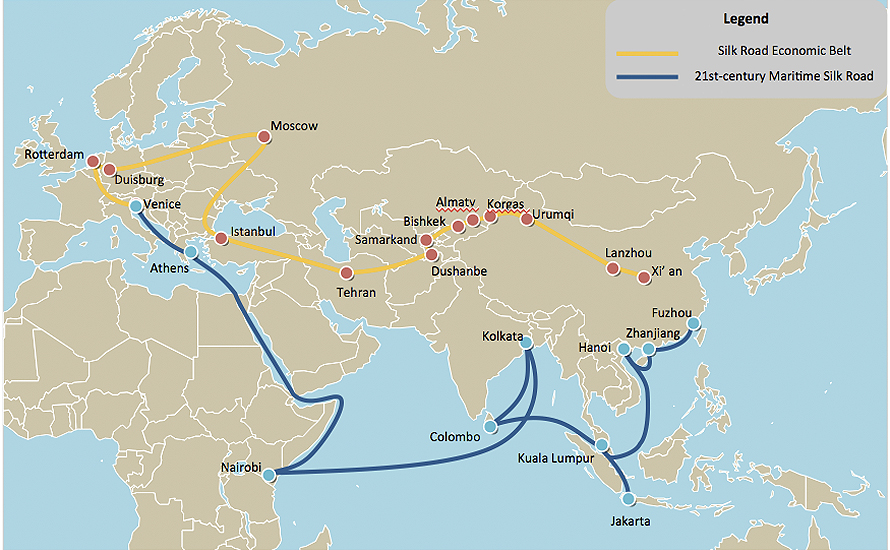The project 'One Belt-One Road' aims to consolidate China's rise as a superpower.
Xi Jinping's ambitious initiative to connect China to the rest of the Eurasian continent may prove costly and difficult. But unlike the overland route through the Central Asian republics, the sea route may not take long to become a reality on certain stretches, as China has already built some ports along part of the route.

▲The land and sea routes of the Chinese initiative [yourfreetemplates].
article / Jimena Puga Gómez [English version].
Following Chinese President Xi Jinping's 2013 revitalisation of the ancient Silk Road speech , the initiative that started as an idea has become the Beijing government's biggest economic challenge: a revolution that, if realised, will change the Asian continent's passenger, freight and hydrocarbon transport infrastructure, as well as high-tech. Dubbed OBOR-OneBelt-One Road, the plan is intended to be the core topic of China's rise as a regional superpower.
The OBOR initiative is a grand plan to reshape China's strategic environment, project Beijing's economic power, secure the communist country's access to energy and mineral supplies, and boost economic growth in the west of the People's Republic. OBOR seeks to achieve these goals by fostering greater and faster connectivity between China and Europe through intermediate points in Central, West and South Asia, as well as with Russia.
For its part, the maritime route that will form one of the pieces core topic of the OBOR initiative, also known as the Silk Road of the 21st century, counts on the fact that seven of the ten largest ports in the world are in China and, as is well known, these infrastructures make the Asian giant an important exporter of port services management .
The Eastbound Maritime Silk Road will start in Fujian province and pass through Guangdong, Guangxi and Hainan, before heading south to the Strait of Malacca. From Kuala Lumpur, the Route will continue to Kolkata and Colombo, then cross the rest of the Indian Ocean towards Nairobi. From there, it will travel through the Horn of Africa, seeking to cross the strategic Gulf of Aden to the Red Sea. Beijing's plan aims to create sufficient infrastructure to allow Chinese ships to safely reach the Mediterranean after sailing through the Suez Canal. But the People's Republic's ambition does not stop at the EU's doorstep, as China wants to reach Athens via the Aegean and from there to Venice, where it will look for land routes to move its goods throughout the Union. Chinese investment has focused, among other things, on the port of Piraeus, with a new logistics centre, and on the development of a network of logistics infrastructures through the Balkans and Hungary.
The South Pacific has also been included in this strategic route map devised in Beijing. Thus, the maritime Silk Road has two routes. The first, as mentioned above, originates on China's east coast and, via the South China Sea, aims to establish strategic control of the Spratley Islands, the Strait of Malacca and the entire Indo-Pacific area, including the Bay of Bengal, in order to reach the heart of Europe. The second sea route will also cross the South China Sea to direct its ships to the coastal ports of the South Pacific. In this way, China would also control the routes for the essential raw materials that come from Latin America.
Although this is a long-term economic project deadline , the Chinese government has already begun the construction of certain infrastructures and the necessary negotiations with different countries. A clear example is Germany. The European Union is China's largest trading partner , while the People's Republic of China is the EU's second largest provider . sample . Germany is a country that not only enjoys an excellent reputation as a reliable partner in China, but is also regarded as "Europe's trade gateway". test This is why, at a meeting in Duisburg, the world's largest inland port and an important transport and logistics hub in Europe, Chinese President Xi Jinping proposed to Germany "to work together to realise the ambitious project of the revival of the economic belt of the new Silk Road of the 21st century". Germany and China are currently connected by the Chongqing-Xinjiang-Duisburg international railway line.
The ports built by China at Hambantota and Colombo in Sri Lanka, the China-Suez Economic and Trade Cooperation Zone in Egypt, Kazakhstan's negotiation of the right to clear its imports and exports through the Chinese port of Lianyungang, and a new alliance between ports in China and Malaysia are further examples of China's ability to leverage its new skill as a port moderniser and manager to support its strategy.
The New Silk Road initiative is a project that will require multi-billion dollar investments in order to build smooth, safe and efficient transport infrastructures. The effects of this economic network ensure benefits not only for China, the leader of the OBOR initiative, but also for all countries affected by it. However, the financing of project is still a question mark that needs to be clarified.